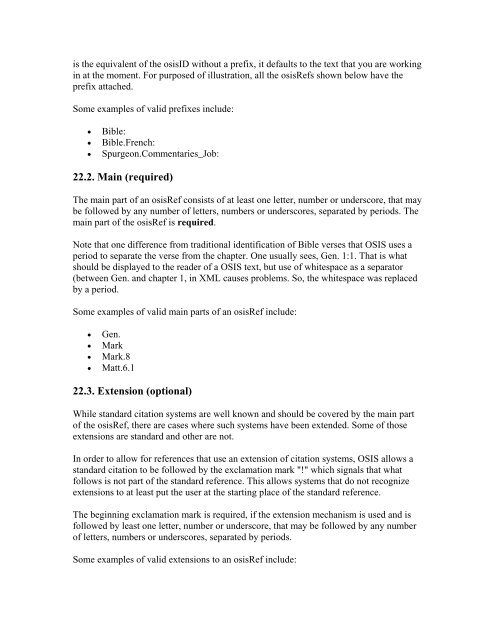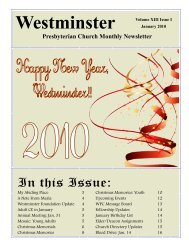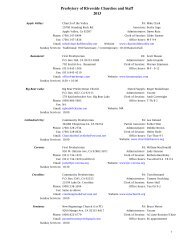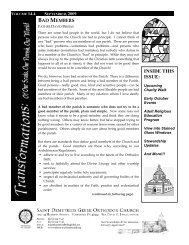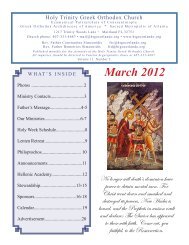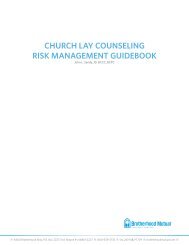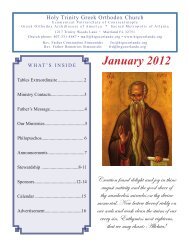OSIS? 2.0.1 User's Manual - Web services are running on AMBIB
OSIS? 2.0.1 User's Manual - Web services are running on AMBIB
OSIS? 2.0.1 User's Manual - Web services are running on AMBIB
You also want an ePaper? Increase the reach of your titles
YUMPU automatically turns print PDFs into web optimized ePapers that Google loves.
is the equivalent of the osisID without a prefix, it defaults to the text that you <str<strong>on</strong>g>are</str<strong>on</strong>g> working<br />
in at the moment. For purposed of illustrati<strong>on</strong>, all the osisRefs shown below have the<br />
prefix attached.<br />
Some examples of valid prefixes include:<br />
• Bible:<br />
• Bible.French:<br />
• Spurge<strong>on</strong>.Commentaries_Job:<br />
22.2. Main (required)<br />
The main part of an osisRef c<strong>on</strong>sists of at least <strong>on</strong>e letter, number or underscore, that may<br />
be followed by any number of letters, numbers or underscores, separated by periods. The<br />
main part of the osisRef is required.<br />
Note that <strong>on</strong>e difference from traditi<strong>on</strong>al identificati<strong>on</strong> of Bible verses that <str<strong>on</strong>g>OSIS</str<strong>on</strong>g> uses a<br />
period to separate the verse from the chapter. One usually sees, Gen. 1:1. That is what<br />
should be displayed to the reader of a <str<strong>on</strong>g>OSIS</str<strong>on</strong>g> text, but use of whitespace as a separator<br />
(between Gen. and chapter 1, in XML causes problems. So, the whitespace was replaced<br />
by a period.<br />
Some examples of valid main parts of an osisRef include:<br />
• Gen.<br />
• Mark<br />
• Mark.8<br />
• Matt.6.1<br />
22.3. Extensi<strong>on</strong> (opti<strong>on</strong>al)<br />
While standard citati<strong>on</strong> systems <str<strong>on</strong>g>are</str<strong>on</strong>g> well known and should be covered by the main part<br />
of the osisRef, there <str<strong>on</strong>g>are</str<strong>on</strong>g> cases where such systems have been extended. Some of those<br />
extensi<strong>on</strong>s <str<strong>on</strong>g>are</str<strong>on</strong>g> standard and other <str<strong>on</strong>g>are</str<strong>on</strong>g> not.<br />
In order to allow for references that use an extensi<strong>on</strong> of citati<strong>on</strong> systems, <str<strong>on</strong>g>OSIS</str<strong>on</strong>g> allows a<br />
standard citati<strong>on</strong> to be followed by the exclamati<strong>on</strong> mark "!" which signals that what<br />
follows is not part of the standard reference. This allows systems that do not recognize<br />
extensi<strong>on</strong>s to at least put the user at the starting place of the standard reference.<br />
The beginning exclamati<strong>on</strong> mark is required, if the extensi<strong>on</strong> mechanism is used and is<br />
followed by least <strong>on</strong>e letter, number or underscore, that may be followed by any number<br />
of letters, numbers or underscores, separated by periods.<br />
Some examples of valid extensi<strong>on</strong>s to an osisRef include:


